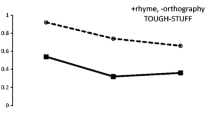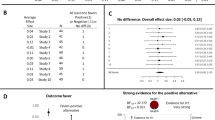Abstract
This paper presents evidence for a new model of the functional anatomy of speech/language (Hickok & Poeppel, 2000) which has, at its core, three central claims: (1) Neural systems supporting the perception of sublexical aspects of speech are essentially bilaterally organized in posterior superior temporal lobe regions; (2) neural systems supporting the production of phonemic aspects of speech comprise a network of predominately left hemisphere systems which includes not only frontal regions, but also superior temporal lobe regions; and (3) the neural systems supporting speech perception and production partially overlap in left superior temporal lobe. This model, which postulates nonidentical but partially overlapping systems involved in the perception and production of speech, explains why psycho- and neurolinguistic evidence is mixed regarding the question of whether input and output phonological systems involve a common network or distinct networks.
Similar content being viewed by others
REFERENCES
Albert, M. L., & Bear, D. (1974). Time to understand; a case study of word deafness with reference to the role of time in auditory comprehension. Brain, 97, 373–384.
Allport, D. A. (1984). Speech production and comprehension: One lexicon or two? In W. Prinz & A. F. Sanders (Eds.), Cognition and motor processes (pp. 209–228). Berlin: Springer-Verlag.
Anderson, J. M., Gilmore, R., Roper, S., Crosson, B., Bauer, R. M., Nadeau, S., Beversdorf, D. Q., Cibula, J., Rogish III, M., Kortencamp, S., Hughes, J. D., Gonzalez Rothi, L. J., & Heilman, K. M. (1999). Conduction aphasia and the arcuate fasciculus: A reexamination of the Wernicke-Geschwind model. Brain and Language, 70, 1–12.
Bachman, D. L., & Albert, M. L. (1988). Auditory comprehension in aphasia. In F. Boller, & J. Grafman (Eds.), Handbook of neuropsychology, Vol.1(pp. 281–306). New York: Elsevier.
Baker, E., Blumsteim, S. E., & Goodglass, H. (1981). Interaction between phonological and semantic factors in auditory comprehension. Neuropsychologia,19, 1–15.
Barde, L. F., Baynes, K., Gage, N., & Hickok, G. (2000). “Phonemic” perception in aphasia and in the isolated right hemisphere. Cognitive Neuroscience Society Annual Meeting Program, 2000, 43.
Binder, J. R., Rao, S. M., Hammeke, T. A., Yetkin, F. Z., Jesmanowicz, A., Bandettini, P. A., Wong, E. C., Estkowski, L. D., Goldstein, M. D., Haughton, V. M., & Hyde, J. S. (1994). Functional magnetic resonance imaging of human auditory cortex. Annals of Neurology, 35, 662–672.
Blumstein, S. (1995). The neurobiology of the sound structure of language. In M. S. Gazzaniga (Ed.), The cognitive neurosciences (pp. 913–929). Cambridge, MA: MIT Press.
Bookheimer, S. Y., Zeffiro, T. A., Blaxton, T., Gaillard, W., & Theodore, W. (1995). Regional cerebral blood flow during object naming and word reading. Human Brain Mapping, 3, 93–106.
Buchman, A. S., Garron, D. C., Trost-Cardamone, J. E., Wichter, M. D., & Schwartz, M. (1986). Word deafness: One hundred years later. Journal of Neurology, Neurosurgery, and Psychiatry, 49, 489–499.
Buchsbaum, B., Hickok, G., & Humphries, C. (2001). Role of left posterior superior temporal gyrus in phonological processing for speech perception and production. Cognitive Science, in press.
Buckner, R. L., Bandettini, P. A., O'Craven, K. M., Savoy, R. L., Petersen, S. E., Raichle, M. E., & Rosen, B. R. (1996). Detection of cortical activation during averaged single trials of a cognitive task using functional magnetic resonance imaging. Proceedings of the National Academy of Sciences, 93, 14878–14883.
Coleman, J. (1998). Cognitive reality and the phonological lexicon: A review. Journal of Neurolinguistics, 11(3), 295–320.
Damasio, A. R. (1992). Aphasia. New England Journal of Medicine, 326, 531–539.
Damasio, H., & Damasio, A. R. (1980). The anatomical basis of conduction aphasia. Brain, 103, 337–350.
Dell, G. S., Schwartz, M. F., Martin, N., Saffran, E. M., & Gagnon, D. A. (1997). Lexical access in aphasic and nonaphasic speakers. Psychological Review, 104, 801–838.
Dhankhar, A., Wexler, B. E., Fulbright, R. K., Halwes, T., Blamire, A. M., & Shulman, R. G. (1997). Functional magnetic resonance imaging assessment of the human brain auditory cortex response to increasing word presentation rates. Journal of Neurophysiology, 77, 476–483.
Dronkers, N. F. (1996). A new brain region for coordinating speech articulation. Nature, 384, 159–161.
Gage, N., Poeppel, D., Roberts, T. P. L., & Hickok, G. (1998). Auditory evoked M100 reflects onset acoustics of speech sounds. Brain Research, 814, 236–239.
Geschwind, N. (1965). Disconnextion syndromes in animals and man. Brain, 88, 237–294, 585–644.
Goodglass, H. (1992). Diagnosis of conduction aphasia. In S. E. Kohn (Ed.), Conduction aphasia (pp. 39–49). Hillsdale, N.J.: Lawrence Erlbaum Associates.
Hickok, G. (2000). Speech perception, conduction aphasia, and the functional neuroanatomy of language. In Y. Grodzinsky, L. Shapiro, & D. Swinney (Eds.), Language and the brain (pp. 87–104). San Diego: Academic Press.
Hickok, G., Erhard, P., Kassubek, J., Helms-Tillery, A. K., Naeve-Velguth, S., Strupp, J. P., Strick, P. L., & Ugurbil, K. (2000). A functional magnetic resonance imaging study of the role of left posterior superior temporal gyrus in speech production: implications for the explanation of conduction aphasia. Neuroscience Letters, 287, 156–160.
Hickok, G., Love, T., Swinney, D., Wong, E. C., & Buxton, R. B. (1997). Functional MR imaging of auditorily presented words: A single-item presentation paradigm. Brain and Language, 58, 197–201.
Hickok, G., & Poeppel, D. (2000). Towards a functional neuroanatomy of speech perception. Trends in Cognitive Sciences, 4, 131–138.
Indefrey, P., & Levelt, W. J. M. (2000). The neural correlates of language production. In M. S. Gazzaniga (Ed.), The new cognitive neurosciences (pp. 845–865). Cambridge, MA: MIT Press.
Kuriki, S., Okita, Y., & Hirata, Y. (1995). Source analysis of magnetic field responses from the human auditory cortex elicited by short speech sounds. Experimental Brain Research, 104, 144–152.
Levelt, W. J. M., Praamstra, P., Meyer, A. S., Helenius, P., & Salmelin, R. (1998). An MEG study of picture naming. Journal of Cognitive Neuroscience, 10, 553–567.
Levelt, W. J. M., Roelofs, A., & Meyer, A. S. (1999). A theory of lexical access in speech production. Behavioral & Brain Sciences,22(1), 1–75.
MacKay, D. G. (1987). The organization of perception and action: a theory for language and other cognitive skills. New York: Springer-Verlag.
Mazoyer, B. M., Tzourio, N., Frak, V., Syrota, A., Murayama, N., Levrier, O., Salamon, G., Dehaene, S., Cohen, L., & Mehler, J. (1993). The cortical representation of speech. Journal of Cognitive Neuroscience, 5, 467–479.
McGlone, J. (1984). Speech comprehension after unilateral injection of sodium amytal. Brain and Language, 22, 150–157.
Papathanassiou, D., Etard, O., Mellet, E., Zago, L., Mazoyer, B., & Tzourio-Mazoyer, N. (2000). A common language network for comprehension and production: A contribution to the definition of language epicenters with PET. Neuroimage, 11, 347–357.
Paus, T., Perry, D. W., Zatorre, R. J., Worsley, K. J., & Evans, A. C. (1996). Modulation of cerebral blood flow in the human auditory cortex during speech: Role of motor-to-sensory discharges. European Journal of Neuroscience, 8, 2236–2246.
Petersen, S. E., Fox, P. T., Posner, M. I., Mintun, M., & Raichle, M. E. (1988). Positron emission tomographic studies of the cortical anatomy of single-word processing. Nature London, 331, 585–589.
Poeppel, D., Yellin, E., Phillips, C., Roberts, T. P. L., Rowley, H., Wexler, K., & Marantz, A. (1996). Task-induced asymmetry of the auditory evoked M100 neuromagnetic field elicited by speech sounds. Cognitive Brain Research, 4, 231–242.
Price, C. J., Wise, R. J. S., Warburton, E. A., Moore, C. J., Howard, D., Patterson, K., Frackowiak, R. S. J., & Friston, K. J. (1996). Hearing and saying: The functional neuroanatomy of auditory word processing. Brain, 119, 919–931.
Schlosser, M. J., Aoyagi, N., Fulbright, R. K., Gore, J. C., & McCarthy, G. (1998). Functional MRI studies of auditory comprehension. Human Brain Mapping, 6, 1–13.
Shelton, J. R., & Caramazza, A. (1999). Deficits in lexical and semantic processing: Implications for models of normal language. Psychonomic Bulletin & Review, 6, 5–27.
Wada, J., & Rasmussen, T. (1960). Intracarotid injection of sodium amytal for the lateralization of cerbral speech dominance. Journal of Neurosurgery, 17, 266–282.
Wilshire, C. E., & McCarthy, R. A. (1996). Experimental investigations of an impairement in phonological encoding. Cognitive Neuropsychology, 13, 1059–1098.
Wise, R., Chollet, F., Hadar, U., Friston, K., Hoffner, E., & Frackowiak, R. (1991). Distribution of cortical neural networks involved in word comprehension and word retrieval. Brain, 114(Pt 4)(5), 1803–17.
Wise R. J. S., Greene, J., B#x00FC;chel, C., & Scott, S. K. (1999). Brain regions involved in articulation. The Lancet, 353, 1057–1061.
Yaqub, B. A., Gascon, G. G., Alnosha, M., & Whitaker, H. (1988). APure wood deafness (acquired verbal auditory agnosia) in an Arabic speaking patientS. Brain, 111, 457–466.
Zaidel, E. (1985). Language in the right hemisphere. In D. F. Benson & E. Zaidel (Eds.), The dual brain: Hemispheric specialization in humans (pp. 205–231). New York: Guilford Press.
Zatorre, R. J., Meyer, E., Gjedde, A., & Evans, A. C. (1996). PET studies of phonetic processing of speech: Review, replication, and reanalysis. Cerebral Cortex, 6, 21–30.
Author information
Authors and Affiliations
Rights and permissions
About this article
Cite this article
Hickok, G. Functional Anatomy of Speech Perception and Speech Production: Psycholinguistic Implications. J Psycholinguist Res 30, 225–235 (2001). https://doi.org/10.1023/A:1010486816667
Issue Date:
DOI: https://doi.org/10.1023/A:1010486816667




